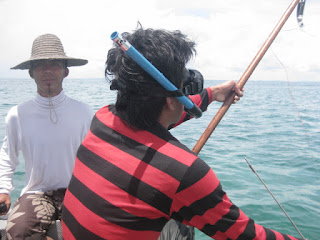The
Bajau or
Bajaw (pronounced
/ˈbædʒɔː/ or
/ˈbɑːdʒaʊ/), also spelled
Bajao,
Badjau,
Badjaw, or
Badjao, are an
indigenous ethnic group of the southern
Philippines. Due to escalated conflicts in their native
Sulu Archipelago of the southern Philippines, many of the Bajau have migrated to neighboring
Malaysia over the course of 50 years. Currently they are the second largest ethnic group in the state of
Sabah, making up 13.4%
[1] of the total population. Groups of Bajau have also migrated to
Sulawesi and
Kalimantan in
Indonesia, although figures of their exact population are unknown.
[2] They were sometimes referred to as the
Sea Gypsies, although the term has been used to encompass a number of non-related ethnic groups with similar traditional lifestyles, such as the
Moken of the Burmese-Thai Mergui Archipelago and the
Orang Laut of southeastern Sumatra and the Riau Islands of Indonesia. The modern outward spread of the Bajau from older inhabited areas seems to have been associated with the development of sea trade in
trepang.
Like the term
Kadazan-dusun, Bajau is a collective term, used to describe several closely related indigenous groups. These Bajau groups also blend culturally with the Sama groups into what is most properly called the Sama-Bajau people. Historically the term "Sama" was used to describe the more land-oriented and settled Sama-Bajau groups, while "Bajau" was used to describe the more sea-oriented, boat-dwelling, nomadic groups. Even these distinctions are fading as the majority of Bajaus have long since abandoned boat living, most for Sama-style piling houses in the coastal shallows. Today, the greatest feature distinguishing the "Bajau" from the "Sama" is their poverty.
The Sama-Bajau peoples speak some ten languages of the Sama-Bajau subgroup of the Western Malayo-Polynesian language family.
[3]
The origin of the word Bajau is not clear cut. It is generally accepted that these groups of people can be termed Bajau, though they never call themselves Bajau. Instead, they call themselves with the names of their tribes, usually the place they live or place of origin. They accept the term Bajau because they realize that they share some vocabulary and general genetic characteristic such as in having darker skin, although the Simunuls appear to be an exception in having fairer skin.
British administrators in Sabah, labeled the Samah as Bajau and put Bajau in their birth certificates as their race. During their time in Malaysia, some have started labeling themselves as their ancestors called themselves, such as Simunul. For political reasons and to ensure easy access to the Malaysian
special privileges granted to Malays, many have started calling themselves Malay. This is especially true for recent Filipino migrants.
For most of their history, the Bajau have been a
nomadic, seafaring people, living off the sea by trading and subsistence fishing.
[5] The boat dwelling Bajau see themselves as non-aggressive people. They kept close to the shore by erecting houses on stilts, and traveled using
lepa-lepa, handmade boats which many lived in.
[5] Although historically originating from the southern Philippine coasts, Sabahan Sama legend narrates that they had originated from members of the royal guard of the
Sultan of
Johor, after the fall of the Malay Malacca empire, who settled along the east coast of Borneo after being driven there by storms. Another version narrates that they were escorting the Sultan's bride, but the bride was later kidnapped by the Sultan of Brunei. The fact that the Bajau-Sama languages belong to the
Philippine branch of
Malayo-Polynesian languages would substantiate the anthropological origins of the Bajau groups to be from the
Philippines, and put the origin legends down to the historic Malay-centric influence of Bajau culture.

















































